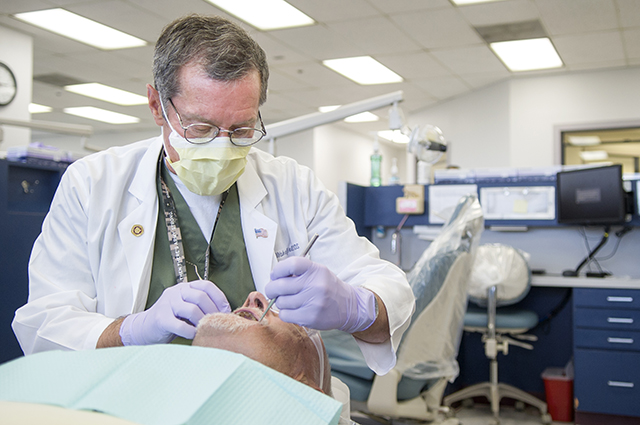Osteonecrosis

When prescription drugs cause adverse effects in the jaw
Attending a cancer support group presentation on the side effects of bisphosphonates gave Jerry Sawyer, 73, a jump-start on managing the symptoms when he experienced them himself.
Sawyer, a cancer survivor, learned from Dr. Charles Wakefield, professor and director of the advanced education in general dentistry residency program at Texas A&M University Baylor College of Dentistry, how to identify the signs of bisphosphonate-induced osteonecrosis of the jaw — a disease where bone loses blood supply and is non vital.
This condition was a side effect of Sawyer’s lengthy cancer battle, which began in late 1995 when he thought he pulled a hamstring while he was refereeing a professional soccer game in Dallas.
An MRI revealed devastating news. What he believed to be a pulled hamstring was actually his vertebrae collapsing and pinching a nerve due to a tumor in his spinal column. He was diagnosed with multiple myeloma and given a life expectancy of two years or less.
After seeing an oncologist, Sawyer immediately began taking the intravenous prescription drug Aredia, a bisphosphonate. With names like Aredia, Fosamax, Boniva, Actonel, Reclast and Zometa, among others, this class of drugs is used to treat the high blood calcium levels and bone disease experienced by patients with multiple myeloma and other metastatic bone cancers. Bisphosphonates also are prescribed to treat patients with osteoporosis, Paget’s disease and similar conditions found in patients over age 55.
In these diseases, the natural process of replacing old bone tissue with new is thrown out of kilter. Bisphosphonates work by killing off the cells that break down bone, restoring the balance of bone loss/formation that occurs in healthy bodies and decreasing fracture risk.
“Bone is continually remodeled — it is formed and resorbed, usually at a constant balance of resorption and formation,” Wakefield said. “Bisphosphonates, as a rule, can permanently decrease the cells that resorb bone, allowing the other cells that form bone to continue forming it.”
After 14 months on Aredia, Sawyer wanted to stop treatment to avoid becoming immune to the drug. He was symptom-free for several years, then resumed treatment with a different drug.
“Switching drugs became the worst thing I could do,” he said. He developed bisphosphonate-induced osteonecrosis of the jaw (ONJ).
Although osteonecrosis can develop in bone in other areas of the body, the jaws are most susceptible because that area of the skeleton has a very high degree of turnover due to the stress and function of chewing. ONJ is found in the lower jaw 60 percent of the time and upper jaw the other 40 percent, Wakefield said. The condition presents as exposed alveolar bone — the bone that contains the tooth sockets — and occurs spontaneously or following a surgical procedure such as tooth removal, periodontal surgery or dental implant placement.
According to Wakefield, patients receiving bisphosphonates intravenously are most susceptible since the medications are almost totally absorbed by the bone. Bisphosphonates taken orally are partially absorbed in the stomach, so they have less risk, but they still can contribute to ONJ after two to three years of constant use. Regardless of delivery method, this class of drugs remains in the body indefinitely.
“These medications concentrate in bone and remain unaltered metabolically for decades, even after being discontinued,” Wakefield said.
Sawyer recognized the signs of osteonecrosis in his jaw when he discovered something unusual adjacent to his molar.
“I knew what was going on as soon as I felt what seemed like a new wisdom tooth,” Sawyer said.
Sawyer was examined at TAMBCD, and his suspicions were confirmed. The unusual protrusion was exposed bone that Sawyer could remove in pieces with his fingers. After his official diagnosis of ONJ, Sawyer was given antibiotics for 10 days and started on the treatment protocol Wakefield wrote for the college.
“There are many steps in the treatment plan, from just managing the symptoms and exposed bone to surgical removal,” Wakefield said. “Since surgical removal is much more traumatic, normal healing may not occur. Hyperbaric oxygen therapy is an option but is controversial regarding benefits. With no blood supply, the oxygen isn’t delivered to all sites.
“If exposed bone is sharp and causes irritation, we file it smooth for patient comfort. Whenever the patient has any dentistry done, even cleanings, antibiotics are prescribed and the patient is given antimicrobial mouthrinses for 60 days.”
Wakefield said it is important that patients have a thorough dental examination and complete any major dental work such as implant placement and healing, extractions and periodontal procedures before beginning a bisphosphonate regime or as soon as possible after starting the drug therapy.
Sawyer said his oral condition is more aggravating than it is painful.
“I’m fortunate,” he said. “A lot of people who have ONJ get an open mouth sore that won’t heal, they have to live with that and it is painful.”
Sawyer is facing other health challenges beyond the osteonecrosis. More than one of the medications he took for multiple myeloma and its complications caused severe damage to his heart and lungs, he said. In addition, he “is in the midst of relapsing” and expects to have to start treatment again.
The one thing he would change if he could: “I wouldn’t have used the Zometa,” he said. But Sawyer is thankful for his life-extending therapy.
“The drugs that caused my condition, also gave me 16 more years.”